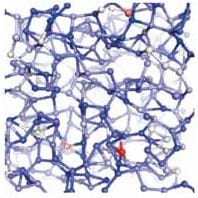There is no more important problem in condensed matter science than inferring the atomistic structure of materials from experiments. For crystals, even immensely complex ones such as proteins, success has been profound, resulting in a Nobel Prize for Protein Crystallography as recently as 2009. For disordered systems, there is vast room for improvement. This collection of papers honoring Prof. Stephen Elliott of the University of Cambridge includes a contribution that points the way to real advances on this problem.
 Matthew Cliffe and Andrew Goodwin are undertaking outstanding work on reconstructing computer models from experimental data. In their recent paper in Physica Status Solidi B, they make a considerable advance by introducing a new concept for structural modeling, the “Principle of Parsimony”; essentially the idea that the model should satisfy all experiments, and, in addition make the least extreme or biased assignments consistent with these data. Researchers have proposed various sensible but ad hoc remedies to improve models inferred from experiment, such as including constraints on bonding and coordination, but these introduce bias into the modeling, which may be inconsistent or only partly consistent with data. While “Parsimony” is not yet fully implemented, I expect that their mode of thinking will lead to a variational principle of the form: Maximize the “parsimony” subject to the model agreeing with experiments. There is a long history of success to this type of approach.
Matthew Cliffe and Andrew Goodwin are undertaking outstanding work on reconstructing computer models from experimental data. In their recent paper in Physica Status Solidi B, they make a considerable advance by introducing a new concept for structural modeling, the “Principle of Parsimony”; essentially the idea that the model should satisfy all experiments, and, in addition make the least extreme or biased assignments consistent with these data. Researchers have proposed various sensible but ad hoc remedies to improve models inferred from experiment, such as including constraints on bonding and coordination, but these introduce bias into the modeling, which may be inconsistent or only partly consistent with data. While “Parsimony” is not yet fully implemented, I expect that their mode of thinking will lead to a variational principle of the form: Maximize the “parsimony” subject to the model agreeing with experiments. There is a long history of success to this type of approach.
The thirteenth century English friar and philosopher William of Ockham (who studied at Oxford, where Cliffe and Goodwin work) was perhaps the first to clearly express the concept of logical Parsimony. In some ways, their work also reminds us of the logic of the Principle of Maximum Entropy as most clearly explained by E. T. Jaynes. There, the idea is to select a solution that can happen in the most ways consistent with experimental information.
While this paper does not completely solve this pressing problem, it formulates the problem in an appealing way that I believe may lead to a new paradigm for solving the structural inversion problem.
This article forms part of Disorder in Order: A special issue on amorphous materials honoring S.R. Elliott that is currently being built up. Guest Editors David Drabold, Sergei Taraskin, and Alex Kolobov bring together more than 20 high-level articles. The scope of the special issue ranges from predicting the properties of phase change materials to the use of mid-IR light as a diagnostic for in vivo detection of skin cancer. This rich diversity of topics reflects the interests of Prof. Elliott, who is being honored with this special collection. Original Papers represent latest original results, and are complemented by Review Articles and Past & Present contributions.
Published so far in physica status solidi (b):
Matthew J. Cliffe and Andrew L. Goodwin
Quantification of local geometry and local symmetry in models of disordered materials [Editor’s Choice]
Y. Li and D. A. Drabold
Symmetry breaking and low energy conformational fluctuations in amorphous graphene [Original Paper]
Keiji Tanaka
Excitation-energy-dependent photoluminescence in glassy As–S and crystalline As2S3 [Original Paper]
Donghui Zhao, Himanshu Jain, Luis C. Malacarne and Paulo R. B. Pedreira
Role of photothermal effect in photoexpansion of chalcogenide glasses [Original Paper]
A. C. Wright and M. F. Thorpe
Eighty years of random networks [Past & Present]
More to come soon! Please watch out for further articles on
http://onlinelibrary.wiley.com/journal/10.1002/(ISSN)1521-3951/earlyview

















